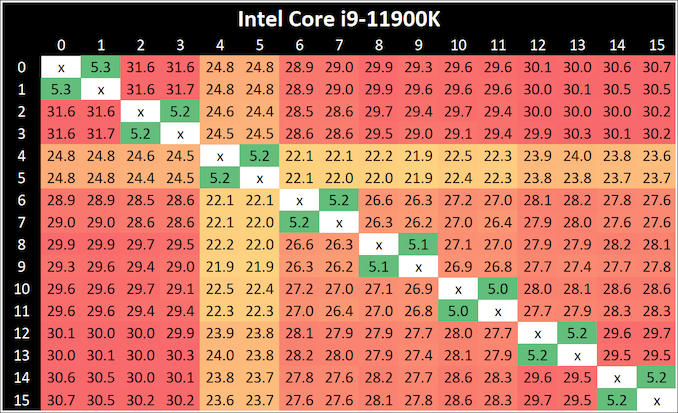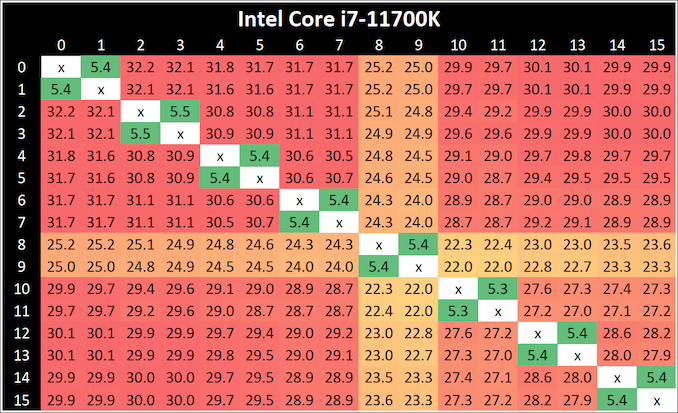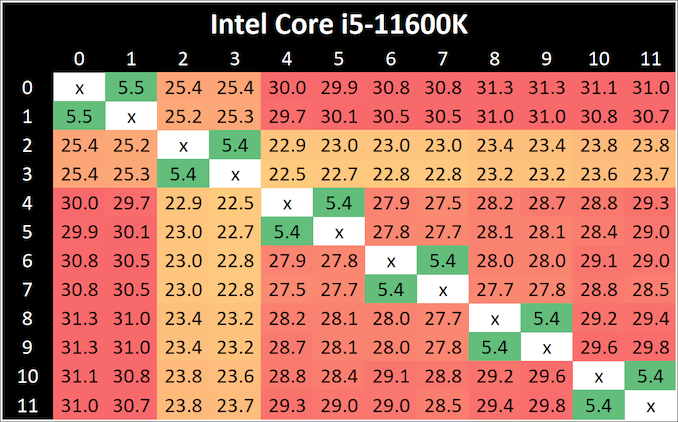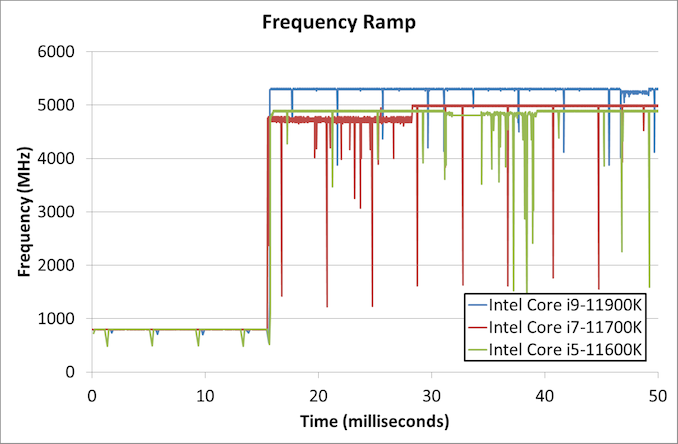Intel Rocket Lake (14nm) Review: Core i9-11900K, Core i7-11700K, and Core i5-11600K
by Dr. Ian Cutress on March 30, 2021 10:03 AM EST- Posted in
- CPUs
- Intel
- LGA1200
- 11th Gen
- Rocket Lake
- Z590
- B560
- Core i9-11900K
CPU Tests: Microbenchmarks
Core-to-Core Latency
As the core count of modern CPUs is growing, we are reaching a time when the time to access each core from a different core is no longer a constant. Even before the advent of heterogeneous SoC designs, processors built on large rings or meshes can have different latencies to access the nearest core compared to the furthest core. This rings true especially in multi-socket server environments.
But modern CPUs, even desktop and consumer CPUs, can have variable access latency to get to another core. For example, in the first generation Threadripper CPUs, we had four chips on the package, each with 8 threads, and each with a different core-to-core latency depending on if it was on-die or off-die. This gets more complex with products like Lakefield, which has two different communication buses depending on which core is talking to which.
If you are a regular reader of AnandTech’s CPU reviews, you will recognize our Core-to-Core latency test. It’s a great way to show exactly how groups of cores are laid out on the silicon. This is a custom in-house test built by Andrei, and we know there are competing tests out there, but we feel ours is the most accurate to how quick an access between two cores can happen.
All three CPUs exhibit the same behaviour - one core seems to be given high priority, while the rest are not.
Frequency Ramping
Both AMD and Intel over the past few years have introduced features to their processors that speed up the time from when a CPU moves from idle into a high powered state. The effect of this means that users can get peak performance quicker, but the biggest knock-on effect for this is with battery life in mobile devices, especially if a system can turbo up quick and turbo down quick, ensuring that it stays in the lowest and most efficient power state for as long as possible.
Intel’s technology is called SpeedShift, although SpeedShift was not enabled until Skylake.
One of the issues though with this technology is that sometimes the adjustments in frequency can be so fast, software cannot detect them. If the frequency is changing on the order of microseconds, but your software is only probing frequency in milliseconds (or seconds), then quick changes will be missed. Not only that, as an observer probing the frequency, you could be affecting the actual turbo performance. When the CPU is changing frequency, it essentially has to pause all compute while it aligns the frequency rate of the whole core.
We wrote an extensive review analysis piece on this, called ‘Reaching for Turbo: Aligning Perception with AMD’s Frequency Metrics’, due to an issue where users were not observing the peak turbo speeds for AMD’s processors.
We got around the issue by making the frequency probing the workload causing the turbo. The software is able to detect frequency adjustments on a microsecond scale, so we can see how well a system can get to those boost frequencies. Our Frequency Ramp tool has already been in use in a number of reviews.
From an idle frequency of 800 MHz, It takes ~16 ms for Intel to boost to the top frequency for both the i9 and the i5. The i7 was most of the way there, but took an addition 10 ms or so.














279 Comments
View All Comments
Qasar - Tuesday, March 30, 2021 - link
nope zen 3, they are waiting for the ryzen 5000 series to be in stock, and once they do, they will upgrade, some were looking at 5600X or 5800X, but now, might move up a tier vs what they would of picked up if they were in stock from day one.Tomatotech - Tuesday, March 30, 2021 - link
Is there a problem with your keyboard? It doesn’t seem able to type the word ‘shit’ properly. Seems a common problem with American keyboards.Holliday75 - Tuesday, March 30, 2021 - link
I have an American keyboard.Shit.
Works for me.
ImSteevin - Tuesday, March 30, 2021 - link
AMD got used to fighting hard with reduced resources and Intel got used to being comfy at the top. Bought AMD at $13, always believed in the real MVP.SaturnusDK - Wednesday, March 31, 2021 - link
I bought AMD shares when they hit the $2 mark. I usually do that when any tech stock hits $2 and I have some spare cash, and then keep it for a minimum of a year. In 2016 it was AMD .Last year it was Kodak.JayNor - Tuesday, March 30, 2021 - link
"AMD is the top dog and intel cannot even catch up...."Intel is already sampling 16 core 24 thread Alder Lake chips ... pcie5, ddr5, new cores. They showed a desktop running it at CES. When will AMD catch up with these features?
SkyBill40 - Tuesday, March 30, 2021 - link
Intel couldn't get 10nm on desktop, yet we're supposed to believe that they're suddenly going to pull a magic rabbit out of a hat tomorrow? Hardly. By the time Intel gets around to having a worthwhile process on something other than 14nm, AMD will be on 5nm. They're almost there as is.16/24? Why bother with that when AMD has 16/32 NOW? While it may not have PCI-E5 or DDR5, it doesn't need it but will likely have it soon enough. AMD catch up? Come on, man. AMD is in FRONT and has been for a while now. It's all about Intel getting it together and trying to close the gap they themselves created due to complacency, mismanagement, and underestimating their opponent.
Qasar - Tuesday, March 30, 2021 - link
jaynor, i think that will be Zen 4, for the most part, its intel that has caught up to AMD with its features. and um if you haven't noticed even with a release bios, microcode etc, looks like rocket lake is still the dud AT shows it was turning out to be a couple of weeks ago.Hifihedgehog - Tuesday, March 30, 2021 - link
> Intel is already sampling 16 core 24 threadLOL. 16 cores and 32 threads of full fat Zen cores is ALWAYS better than 8 cores and 16 threads of full fat Core cores and 8 cores and 8 threads of garbage tier Atom cores.
flgt - Tuesday, March 30, 2021 - link
Yeah, that seems like a mobile first design which will be “good enough” for corporate desktops. Seems like Intel is giving up on the desktop enthusiast market.